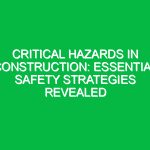Understanding Hazards in the Work Environment
Hazards in the work environment refer to any condition, practice, or substance that poses a potential risk to the health and Safety of employees. This encompasses a wide range of elements, from chemical exposures to physical dangers, ergonomic challenges, and psychological stressors. Within the Health, Safety, and Environment (HSE) domain, identifying and mitigating these Hazards is paramount to ensuring a safe and productive workplace.
The importance of addressing hazards in the work environment cannot be overstated. A safe work environment not only protects employees but also enhances productivity, reduces absenteeism, and fosters a positive organizational culture. In this article, we will explore various types of hazards, practical Safety tips, and the regulatory framework that governs Workplace Safety.
Types of Hazards in the Work Environment
1. Physical Hazards
Physical hazards are among the most common types encountered in various workplaces. They include elements such as slips, trips, falls, machinery hazards, and noise exposure. For instance, a construction site often has uneven surfaces, which can lead to trips and falls if Safety Measures are not implemented.
- **Slips, Trips, and Falls:** One of the leading causes of workplace injuries, often resulting from wet floors, cluttered walkways, or poor lighting.
- **Machinery Hazards:** In industries where heavy machinery is used, improper guards or lack of safety protocols can result in severe injuries.
- **Noise Exposure:** Prolonged exposure to loud environments can lead to hearing loss and other health complications.
2. Chemical Hazards
Chemical hazards arise from exposure to harmful substances, including fumes, vapors, and spills. These hazards are particularly prevalent in manufacturing, laboratories, and construction sites. Employees may face risks such as chemical Burns, respiratory issues, and long-term health Effects from chronic exposure.
- **Toxic Substances:** Chemicals that can cause health issues such as lead, asbestos, or benzene.
- **Corrosive Materials:** Substances that can destroy or damage living tissue or severely corrode materials.
- **Flammable Liquids:** Improper storage or handling of flammable materials can lead to Fires or explosions.
3. Ergonomic Hazards
Ergonomic hazards stem from workplace design and the arrangement of tasks that may lead to musculoskeletal disorders. These types of hazards often occur in office settings, manufacturing plants, and any environment requiring repetitive movements or awkward postures.
- **Poor Workspace Design:** Inadequate desk height or seating arrangements can lead to back pain and repetitive strain injuries.
- **Repetitive Motion:** Tasks that require repetitive movements, such as typing or assembly line work, can cause strain over time.
- **Static Postures:** Remaining in one position for an extended period can lead to discomfort and injury.
4. Biological Hazards
Biological hazards include exposure to harmful microorganisms such as bacteria, viruses, fungi, and parasites. These hazards are particularly significant in healthcare settings, laboratories, and any environment where exposure to bodily fluids may occur.
- **Infectious Diseases:** Healthcare workers are at risk of exposure to diseases such as influenza, hepatitis, and COVID-19.
- **Allergens:** Exposure to substances that can trigger allergic reactions, such as mold or dust mites.
- **Vector-Borne Diseases:** Risks associated with pests like mosquitoes or ticks that can transmit diseases.
5. Psychological Hazards
Psychological hazards involve factors that can lead to mental health issues, stress, and overall employee dissatisfaction. These include workplace bullying, excessive workload, and lack of support.
- **Stressors:** High-pressure environments can lead to burnout and decreased productivity.
- **Harassment:** Bullying or discrimination contributes to a toxic work culture.
- **Poor Work-Life Balance:** Factors that prevent employees from maintaining a healthy separation between work and personal life can lead to psychological strain.
Essential Safety Tips to Mitigate Hazards in the Work Environment
1. Conduct Regular Risk Assessments
One of the most effective ways to identify hazards in the work environment is to conduct regular risk assessments. These assessments help organizations pinpoint potential risks and develop strategies to mitigate them. Involve employees in this process, as they can provide valuable insights into hazards they encounter daily.
2. Implement Safety Training Programs
Providing comprehensive safety training is essential for ensuring employees are aware of potential hazards and how to manage them. Training should cover emergency Procedures, proper use of Personal Protective Equipment (PPE), and safe handling of hazardous materials. For example, a construction firm might hold monthly safety meetings to discuss recent incidents and reinforce Safe Practices.
3. Use Proper Personal Protective Equipment (PPE)
Employers must provide the necessary PPE to protect workers from identified hazards. This includes helmets, gloves, eye protection, and hearing protection, depending on the work environment. Employees should be trained on how to use and maintain their PPE effectively. A construction worker, for instance, should never enter a site without a hard hat and Safety Glasses.
4. Maintain Clean and Organized Workspaces
A cluttered workstation can lead to increased hazards. Encourage employees to keep their areas tidy and free from unnecessary items. Regular cleaning schedules should be established to eliminate potential slip or trip hazards. For example, a busy warehouse should have clear pathways and marked emergency exits.
5. Foster a Positive Safety Culture
Creating a culture that prioritizes safety is vital. Encourage open communication about safety concerns and ensure employees feel empowered to report hazards without fear of reprisal. Recognize and reward safe behavior to reinforce the importance of safety. For instance, a manufacturing plant might implement a “Safety Star” program to acknowledge employees who demonstrate exemplary safety practices.
Regulations and Standards Governing Hazards in the Work Environment
Various Regulations and standards govern hazards in the work environment to ensure the safety and health of employees. In the United States, the Occupational Safety and Health Administration (OSHA) sets and enforces standards for Workplace Safety. These regulations require employers to provide a workplace free from recognized hazards and to adhere to specific safety protocols.
Additionally, international standards such as ISO 45001 provide frameworks for Occupational Health and safety management systems. These guidelines help organizations identify hazards, assess risks, and implement appropriate controls to enhance safety performance.
Conclusion
Identifying and mitigating hazards in the work environment is crucial for promoting health, safety, and environmental Sustainability. Through regular risk assessments, effective training, and fostering a culture of safety, organizations can significantly reduce the risks associated with workplace hazards.
As we continue to navigate the complexities of modern work environments, it is imperative for both employers and employees to remain vigilant. Regularly revisiting safety protocols and staying informed about potential hazards can lead to a healthier and safer workplace for all. Taking action now not only protects lives but also contributes to the overall success of the organization.


